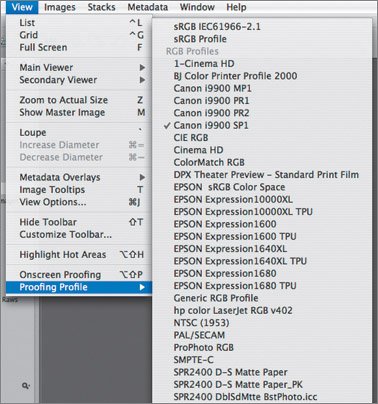Soft Proofing Images
| No matter what your final output type, you'll often perform preliminary proofs onscreen. Onscreen proofing, also called soft proofing, is the most cost-effective way to get client approval before spending money on printed materials. While onscreen proofing is a perfectly accurate way to judge the composition of an image, when it comes to color, contrast, and tone, things get far more complicated. Because of the different technologies used to generate color onscreen and in print, your onscreen images may look very different from the printed versions. In order to make accurate assessments of the color, contrast, and tone of images onscreen you need to use ICC profiles. An ICC profile is a description of the color characteristics of a particular device. ICC profiles are used by ColorSync, the color-management system that's built in to the Mac OS, to create accurate onscreen soft proofs without actually changing the color data in your image file. If you're using an Apple display, then your Mac already includes a built-in generic ICC profile for that device. Third-party displays and printers usually ship with their own profiles, and you can also create custom profiles using third-party software. For the purposes of this exercise, the built-in profiles that came with your display and printer will suffice.
Your success with soft proofing will vary depending on the quality of your display and the quality of your ICC profiles. Also, be aware that no matter how good your profiles are, your printed output will never exactly match your display. The difference between a self-illuminated image created from an additive mixture of light is simply different from a reflective image created from a subtractive mixture of pigments. However, a soft proof should be closer to your print than a regular onscreen image, and over time you'll learn how to predict the differences and adjust accordingly. To learn more about color management and ICC profiling, see Apple Pro Training Series: Color Management in Mac OS X, by Joshua Weisberg. Tip Use the ColorSync utility that comes with Mac OS X to see what ICC profiles you have installed: Open the utility, located in the Applications > Utilities folder, click the Devices icon, and then click the disclosure triangles from the device list at left to see the profiles on your system for each type of device. Most printers ship with multiple profiles, so you may see several listed. |
EAN: 2147483647
Pages: 190
